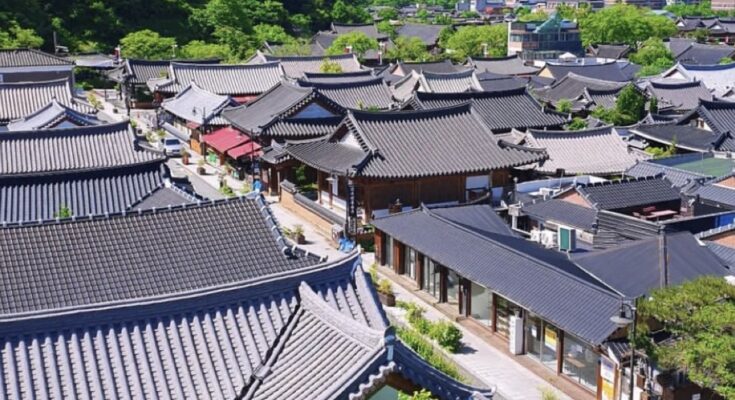Jeonju Hanok Village (Korean: 전주한옥마을) is a village in the city of Jeonju, South Korea, and overlaps with the Pungnam-dong and Gyo-dong neighborhoods. The village contains over 800 Korean traditional houses called Hanok.[1] The village is famous among Koreans and tourists because of its traditional buildings that strongly contrast with the modern city around it. The village was designated as an International Slow City in 2010 in recognition of its relaxed pace of life where traditional culture and nature blend harmoniously.[2] The number of visitors to Jeonju Hanok Village has increased sharply since the 2000s. The visitor numbers more than doubled from 2007 to 2014, from 3.17 million to 7.89 million. Excluding Seoul, Jeonju is ranked third among major tourist cities throughout Korea, behind Jeju and Busan.[3]
History

The City of Jeonju has played a key role in the long history of Korea. The city was once the capital of the Hubaekje Kingdom, which was founded by Kyŏn Hwŏn in the 900s.[4] The city was regarded as the spiritual capital of the Joseon Dynasty because the Yi royal family was from there. In the Joseon Dynasty, Jeonju governed the Jeolla-do area along with Jeju Island, which was considered the center of administration. This is why the city is called ‘the ground of more than 1000 years history’.[4]
People first settled in the Jeonju area over 10,000 years ago. At first, people lived around the foot of a mountain. Then, in the Silla kingdom, people moved into the flat land surrounding the mountain. People in Jeonju began constructing the city’s defensive wall and many villages naturally formed around the city. These villages were the beginning of the current Hanok village. After the demolition of the Jeonju’s city wall during the Korean Empire period, the residential area within the wall began to expand throughout the Pungnam-dong and Gyo-dong districts led by the Yangban. The village has become one of the most popular tourist attractions of Jeonju.[5]
Attractions

Jeondong Cathedral
The Jeondong Catholic Church in Jeonju (Historic Site No. 288) was completed in 1914 and was designed by Priest Poinel, who also designed the famous Myeongdong Cathedral in Seoul. It is the largest and oldest western-style structure in the Jeollanam-do and Jeollabuk-do provinces. The church was built where the first Korean Catholic martyr, Yun Ji-chung (1759-1791), died.[6] The architectural style of the Jeondong Cathedral is a mixture of the Romanesque and Byzantine styles and is considered one of the most beautiful buildings in Korea.[7]
Omokdae

Located on the east side of Hanok Village is the place where Lee Seonggae, founder of the Joseon Dynasty, gave an outdoor banquet in Jeonju during his triumphant return to Gaegyeong after a victory over Japanese coastal invaders at Hwangsan Mt.[8] It is located at a high elevation, making it a good place to view the surrounding scenery. Many tourists start their journey here.[9]

Jeonju Hyanggyo
The Jeonju Hyanggyo was a Confucian temple and school for students in Jeonju during the Joseon Dynasty period.[10] It was first built by the King of Gongmin in 1354, during the Goryeo Dynasty period. It was originally located at the Gyeonggijeon Shrine site in Jeonju; however it was relocated twice after two wars. The main room in the shrine area, the Daeseongjeon (Confucian Shrine Hall), in located in the front, while the main room in the teaching area, the Myeongyundang (lecture hall), is located in the rear. This is an unusual configuration for a hyanggyo. In all, there are 99 rooms at the Jeonju Hyanggyo.[11] It is the Korean Historical Treasure #379.[12]



